The Cal Bears Culture Has a Powerful Influence – Past and Present; Dave Durden Guiding a Family
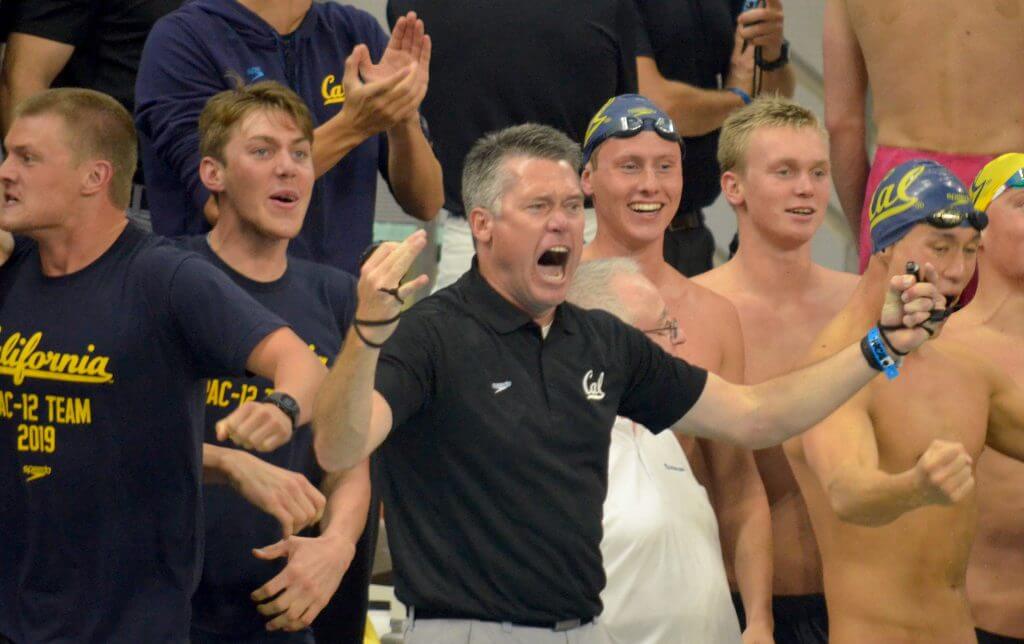
The Cal Bears Culture Has a Powerful Influence – Past and Present; Dave Durden Guiding a Family
When you’ve been a battle-tested Marine, an assistant on uber-successful club and college championship teams and confidant to Olympians, you know something about winning. Jack Roach has been all of those and more. So, feel safe in believing him when he says: “There is only one thing that trumps talent—and that is culture.”
When asked, many high-profile coaches point to the University of California men as a squad with one of the best team mores. Its roots date to 1963 when Peter Cutino was named swimming and water polo coach. Cutino’s specialty and real success came in water polo. He was “detailed and intense,” says former player and later Cal coach, Kirk Everist. “He was always there to administer discomfort.” That discomfort landed the Bears eight NCAA water polo titles, produced 41 All-Americans and earned Cutino jobs as U.S. National Team and Olympic coach and four national coach of the year awards.
Cutino relinquished his swimming duties in 1974 to Nort Thornton, who held the reins through 2007. Thornton actively recruited international athletes, won two NCAA titles and developed 48 Olympians—including Matt Biondi, Anthony Ervin, Par Arvidsson, Bengt Baron—and recruited Nathan Adrian and Duje Draganja. He also persuaded 1980 Olympian Mike Bottom to join him in Berkeley. The two were together for nine years before Thornton retired and was succeeded by Dave Durden.
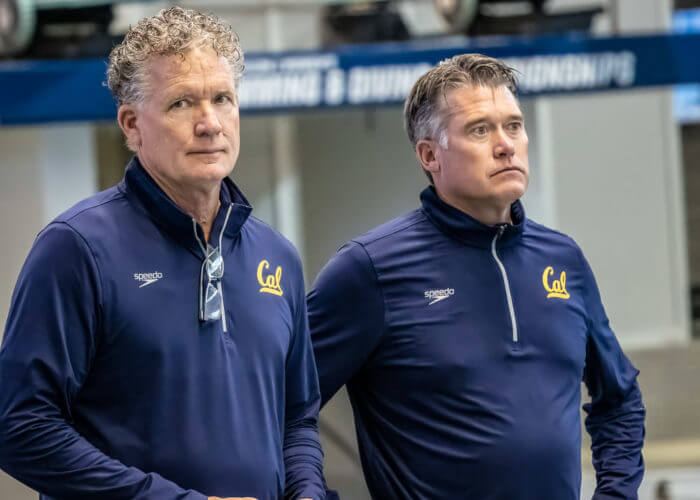
Photo Courtesy: Peter H. Bick
“The Nort Thornton-Mike Bottom era is a critical part of the culture,” said current Cal associate head coach David Marsh. Known as a creative innovator, “Nort set the psychology of the program and brought it to a championship level in the early ‘80’s,” said Marsh.
“I swam for Nort at some point,” noted Bottom. “I loved him; he was a hero, but Nort was not a leader who exerted himself over other people. He allowed things to move as they moved and gave authority to coaches. Nort was a servant leader. He would do anything and everything, including putting in lane lines, to demonstrate to all of us there was no one person who stood above another.”
While the all-for-one thinking was Nort’s modus operandi, it was not the natural culture, especially in the international realm from whence many of Cal’s best came. “This culture needed to be influenced by the team and coaches around the program. Nort mentored us in this direction and expected that we would lead the team toward this end. Some coaches and team leaders did not pick up on Nort’s lead,” said Bottom. With a concerted effort, especially with his sprint group, Bottom helped individuals understand that they could help themselves by helping others. As that learning took hold, the Bears rebounded from 15th in 1997 to eighth and then again to top-five status at NCAAs.
Upon Thornton’s retirement, Cal enticed Maryland head coach and former Auburn assistant, Dave Durden, to Berkeley. In 16 years, Durden has led the Bears to six NCAA titles (and 14 top-two finishes in 15 years), been named NCAA coach of the year seven times, a World Championship coach three times and an Olympic men’s coach once. “Dave and Nort are not the same,” said Bottom, “but one commonality was that their student-athletes loved to swim for them!”
The Cal culture under both has been transcendent. “There’s a continuum. Dave with his engineering mind is quite different from Nort’s,” said Marsh, who once employed Durden at Auburn during the Tigers’ halcyon years.
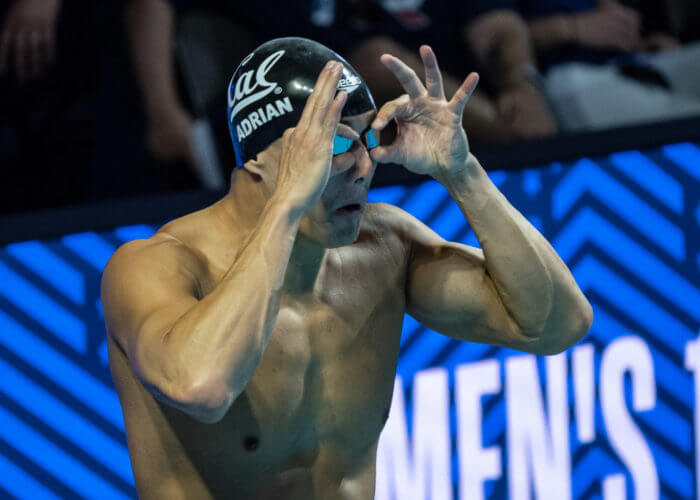
Photo Courtesy: Peter H. Bick
Nathan Adrian, a three-time U.S. Olympian, five-time gold medalist and 14-time U.S. Swimming National Team member, swam for both Thornton and Durden. “Nort had achieved the highest level of success during his tenure, and I went to Cal with the hopes of becoming an Olympic champion. These goals were with the expectation of having Mike and Nort as my coaches. Both were great coaches who cared about their swimmers,” he said. “I was a freshman under Nort, and I didn’t know what to look for. Nort had a culture of ‘Hey, if you want to be good, I know how to coach that in you. And if you don’t, that’s OK, too.’
“When Dave came in, it felt more intentional in that ‘if you want a place on the team, you need to be giving to the team somehow.’ And it didn’t always have to be in terms of excellence in the pool or in the realm of academics, but perhaps by being super-active in seeking culture. That’s the paradigm Dave managed. All culture comes from the top, and he brought more intentionality to it,” said Adrian.
Swimming World high school swimmer of the year Tom Shields arrived in Berkeley in the fall of 2009: “Dave let it be known that we would be more academic-focused, mid-distance-oriented and not just a stable of sprinters. While the culture was instilled by Dave, buy-in came from the classes above us and swimmers like Pac-10 champion Nolan Koon.
“We decided we were not going to let swimming define us. We were people first. We wanted to be more renaissance men. I was a pretty self-centered guy when I arrived on campus, and I struggled with confidence,” admitted Shields. Yet in short order, he began living what he calls the defining elements of the Cal culture: confidence, attitude, discipline and thinking beyond one’s self. “We had a great training environment and were into mantras. ‘No compromises’ was one.
“We also kept one another accountable in swimming, social situations and the classroom. I became more serious and became part of a brotherhood. In 2011, we were pretty stacked, came together and won NCAAs (and again in 2012) by relying on principles and discipline.
“Dave really brought in that mid-d focus with a goal of being good at everything and being a holistic team. And that comes from a group of dudes that truly love each other more than the sport,” said Shields.
COME AGAIN
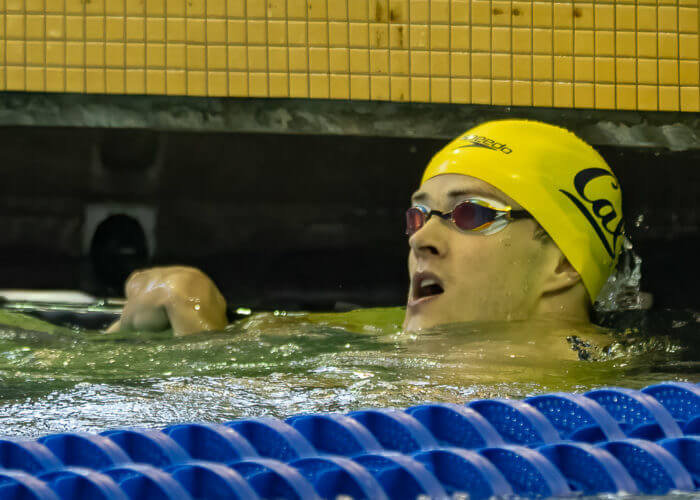
Photo Courtesy: Peter H. Bick
That refrain continues 10 years later. “How much the culture matters to everybody is a part of what makes it so special. I give a lot of credit to those who came before me,” said Cal junior breaststroker Jacob Soderlund. He cites fifth-year Daniel Carr, a 26-time All-American, for showing him the way. “He set the bar for what it was like to be swimming—and being a good teammate—at your highest potential. We want to have the best team culture in the country, and to do that, you have to be a good teammate.’
What struck Soderlund was Carr’s consistency in showing up, putting in 100%, not breathing into the wall and doing extra. “He always did the little details without fail, never left practice without helping someone. He was always finding time to make someone better. Even in the middle of a set, he would notice and say something,” he said.
Soderlund was also struck by the investment that fifth-year swimmers made: “They came back to win and weren’t going to let anything stop them. That really sent the team in the right direction, a behavior that incoming freshmen understood was a team commitment that they should emulate.
“I feel lucky that the book was already written on how to swim fast and have a good culture. You look at the guys who came before you, and they’ve already seen it. You just have to listen to them and do what they tell you. After a while, you realize how to do it yourself and how to inspire those younger than you. It becomes self-sustaining.
“The first day of practice, Dave announces that the highest priority for the year is to get athletes qualified for—and on—the USA Olympic team. He asks us to ‘invest in the process’ and pay as much attention to details as he does. He is the mastermind behind it all,” said Soderlund. “He lays out the training plan, states what the standards are, including how to get in and out of the water. Yes, these are good habits, but what I realized is the importance of doing everything I can to be successful.”
DURDEN, THE MAN
“What people don’t see is the energy that gets built around him,” says Soderlund. “He finds a way to put people on the right path, gives them the tools to succeed as a swimmer and teammate, but he doesn’t do it for them. That’s where accountability steps in. He sets the standards, and the upper classmen are an extension of him in seeing that it gets done.”
Marsh notes that the texture of the Cal culture resides with the athletes who are not stars, but perform well in the trenches. As a voice of experience at the national and international levels, Marsh observes that his Olympic brethren Eddie Reese and Durden share a common trait: “They take care of their teams and rely on the teams to take care of themselves. In operating that way a lot of culture shows up in the locker room.”
It also shows up in humor on deck. “We like to joke around in practice for sure,” said Soderlund. “Yes, we do tough, gritty sets, but we like to keep it loose and have fun. If you have a smile on your face, you are going to swim well. It keeps the energy positive, and you are happy to be on deck. A lot of that comes from sharing experiences and a passion and investment with all of the guys who become your family, and you just have that bond forever.”
Fifth-years and upper classmen aren’t the only ones who contribute to the culture. The Cal pro group has long been considered the gold standard. Initially, all of the post-grads in Durden’s program swam for the Bears during their college years. That only served to amplify the unique Cal connection and mentor relationship with the undergrad swimmers. Early male members of the pro group were Nathan Adrian, Ryan Murphy, Josh Prenot, Jacob Pebley and Shields. Now, he has welcomed outsiders such as Hunter Armstrong and Brooks Curry.
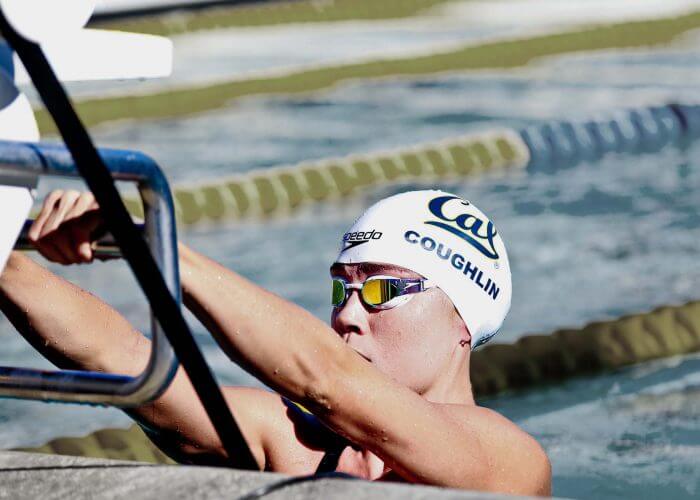
Photo Courtesy: Becca Wyant
The Cal women who excelled on the international stage are now also included in the pro group. But the first was Natalie Coughlin, three-time NCAA Swimmer of the Year and 12-time Olympic medal winner.
The impact of Coughlin as a pro training with the Cal men when she finished her eligibility “was considerable,” said Marsh. “The guys always talked about how she was a ‘Momma Bear’ and showed the way how to do things as a high-level athlete. She had a print on what Dave’s best vision of what culture was,” he says.
“It means a lot to me that I positively impacted the team,” said Coughlin. “Being part of the pro group with Dave was a special time in my swimming career for which I will be forever grateful. Being the sole female on Dave’s men’s team was unusual, and I did my best to add to my teammates’ experiences as much as possible.”
WHY IT WORKED
“I was used to caring for myself, so when the pros traveled to a meet, I often scouted the hotels and flights for the group,” added Coughlin. “I was considerably older than most, so I had to do extra work to care for my body. This meant getting to practice 30 minutes early for stretching and activation, seeing a physical therapist once a week, packing post-workout smoothies…etc. Some of these habits rubbed off on the younger guys.
“Dave did a great job setting clear expectations for the week, training block, season and year. He still has a four-year calendar on his office wall with every critical date for the quad! I thrived knowing the ebbs and flows of the week. He does an incredible job of creating an environment where the majority of the group wants to work their butts off while having a fun time doing so. There were plenty of days when I was exhausted, but I was lifted up by my teammates’ ridiculous jokes, work ethic and good attitude.
“I was fortunate enough to attend this year’s dual meet against ASU (tie, 150-150), and it was a sight to see—easily the best dual meet I have ever witnessed, despite the rainy January day in Berkeley. The men’s and women’s teams at Cal look so strong, and I’m thrilled at the direction the program is heading.”
The program is about to get better if a recent recruiting trend continues.
“Women are seeing the success of the Cal culture and is one reason why recruiting is going to an unprecedented degree,” said Marsh. As of April, the Bears had nabbed the top three female prospects (Teagan O’Dell, Claire Weinstein, Alex Shackell) as well as Annie Jia (#7) and Elle Scott (#10) for their class entering in fall 2025.
OLD FOLKS AT HOME
Make no mistake that upward program trajectory is bolstered by a strong alumni component. More than once, large-bodied Cal alumni like Roque Santos, Shields and Adrian have donned ursine suits to lead Cal cheers and to serve as team ambassadors at the NCAA Championships. “All culture comes from the top,” said Adrian, “and Dave brought more intentionality to it. The bear suit was just one way he captured it. There is a lot of power in the Cal alumni network, but early on, we weren’t doing a good job of harnessing it.”
Cal congregating began in earnest at the 2010 NCAAs “when we had eight alumni in the stands,” said Durden’s wife, Cathy. “At that the meet, we wanted to make sure their experience was unforgettable. They had the time of their lives, hanging out, watching fast swimming and Cal finishing second. They got fired up, went home and rallied the troops, saying we can win next year! Those eight turned into 75 alumni who made the trip to Minnesota to watch Cal win in 2011. We have been able to maintain that level of alumni engagement ever since.”
Cal’s consistent excellence obviously fuels the energy.
“I know the swimmers at NCAAs feel like they have another gear when they look up and see Cal alumni showing up in droves for them. Fast swimming fires up alumni to make the trip again,” Cathy Durden said.
Santos, and others, give the coach’s wife lots of credit for her galvanizing role. “We communicate with the alumni regularly, sending out an email every four to six weeks,” she said. “I provide some behind-the-scenes info that isn’t available to the general public. Sometimes that includes how guys have done on certain sets, sometimes it is a video from Dave or a current swimmer speaking directly to alumni—something that makes them feel like they have insider knowledge.
“We try to make the NCAA experience a little different each year while maintaining the pieces that work really well. The gear each year is a little different and is exclusive to those who make the trip. Whether it is a T-shirt, hat, rally towel, polo shirt, etc., our alumni love swag to represent Cal. We have the alumni and parents interact the entire trip. They generally stay in the same hotels and have a Friday happy hour before finals. The alumni invite the parents out after finals each night. It’s a great relationship.”
“The last thing is just access. Almost every former swimmer who has made the trip to NCAAs has my cell number and Dave’s as well. I get texts from them frequently on all sorts of team-related subjects. We have a level of investment that continues to snowball each year. Dave has done an amazing job keeping this alumni group plugged in and feeling invested in the process. I’ve been lucky to be along for the ride and help out where I can.”
PERPETUAL MOTION
“The culture that Cal is building is an ecosystem to last generations,” said Shields, “and that is all credit to Dave and Cathy and the group around them who perform at a very hard-core level. It’s easy to win one—and it’s hard to keep doing it.”
But it stops no one from trying.




I currently make about 6000-8000 dollars /month for freelancing I do from my home. For those of you who are ready to complete easy online jobs for 2-5 h every day from the comfort of your home and make a solid profit at the same time
.
.
Try this work>>>>> 𝐆𝐞𝐭𝐢𝐧𝐜𝐨𝐦𝐞𝟗.𝐛𝐥𝐨𝐠𝐬𝐩𝐨𝐭.𝐜𝐨𝐦